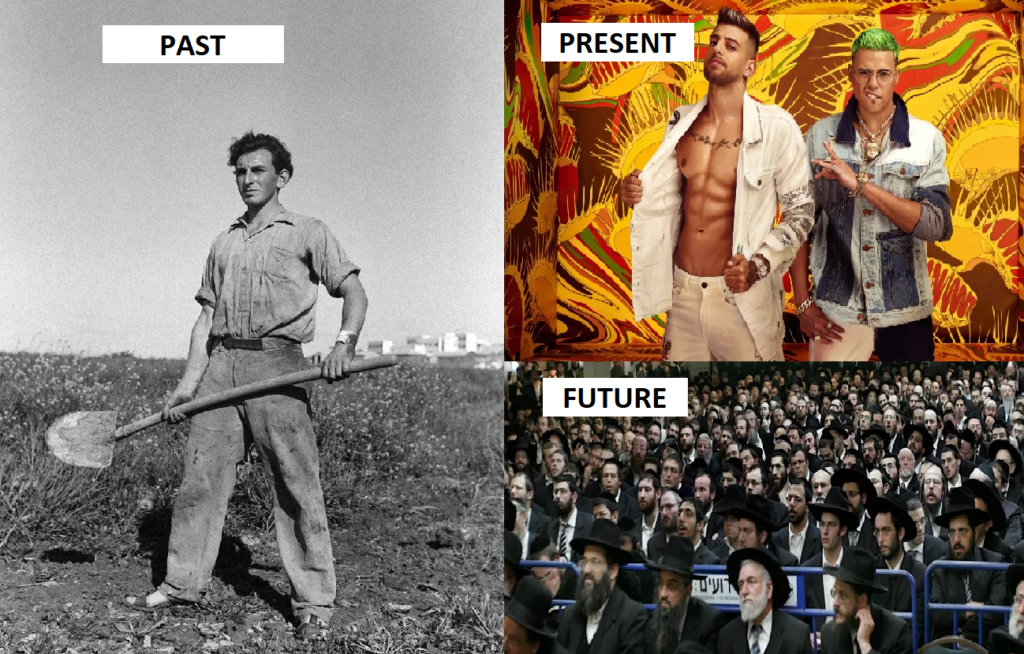
THE GREAT REPLACEMENT: NOTES FROM THE ISRAELI TRENCHES
As Pedro Gonzalez (when will he change his name to Peter Gunnersbury?) recently noted, one of the most imbecilic yet sinister projects of the Left is the denial of the Great Replacement. How common it is to deride those who dare profess the Replacement’s existence as looney conspiracy theorists.
However, without getting into the details, the Great Replacement in America is a simple statistical fact: Back in the late 70s, the European-descended population in America was about 85%. Now it is 59%. This represents a demographic shift on an unprecedented historical scale.
Or not completely unprecedented.
Leaving value-judgment aside, a replacement has been in place in my home country of Israel. And it has changed the country quite a bit and will change it even further.
Upon Israel’s founding in 1948, the country consisted of mere 500,000 Jews. Originally of Eastern European ancestry, these folk were hardened by two generations of Zionism with strong labor and militaristic flavors. They saw themselves as the Biblical reincarnation of Joshua’s troops and settlers. Newcomers at the time would be absorbed into the common ethos. A plethora of youth movements such as Labor Youth, the Young Guardsman, and the Alliance of Joseph Trumperldor might have fought bitterly between themselves but from the remote perspective of almost a century later, were ultimately promoting the same values: Strength, industry, the settlement of the land, and attachment to nature.
Things began to change in the 1950s. Independent Israel became the destination of hundreds of thousands of displaced Jews, both from Eastern Europe and the Middle East. While these newcomers had not been bred in a society of farmer-soldiers, they had nonetheless assimilated fairly quickly into the reigning Spartan ethos, if a bit begrudgingly.
Those were what most Israelis would consider the golden days of the young country. The lyrical music celebrated the beauty of the land and the pain of its defenders, crime was practically unheard of, hitchhiking was a common mode of transportation, many would spend their free time engaged in folk dancing and communal sing-alongs, young children would roam around free and unsupervised, while the guns of Jordan, Syria, Egypt, and Lebanon were all aimed at destroying the fledgling republic.
As a child in the 1980s in a very rural area, I still remember the last rays of that setting golden sun. But elsewhere, things were already changing rapidly. The newcomers of the 1950s and 1960s, or at least their descendants, had reached political and cultural consciousness by then, proving their assimilation was not exactly complete. The lyrical sounds of old Israel were being replaced by strange Middle Eastern tunes, and although social trust was still high, the Spartan country of the founders was by and large gone.
Fast forward to the 1990s and about a million Russian immigrants were added to the 50-year-old country of about six million inhabitants. That population’s contribution to the economy was splendid and dramatic, launching what today is referred to as the “Start-Up Nation.” But also for the first time, you could find in the news tales of drunkenness and horrific spousal abuse, you might observe strange punk-rock-gothic types, and notice a certain cynicism that had not existed before.
As an anecdote, young Israel of the 1960s was not a drinking society at all. My father, who was very popular in his high school, has all these old pictures of him and his buddies trying to act cool, posing by the communal swimming pool and holding onto bottles of… Coca Cola. It was a very sheltered place. The government even forbade the Beatles from visiting, fearing a “corruption” of the youth.
Anyhow, that was perhaps the First Great Replacement in Israel. The Second Great Replacement is still in the works and is even more profound.
While the rise in the non-founding-stock population in the 1950s and 1960s has resulted in a cultural change, it still provided a foundation for a fairly normal (by Western standards) society engaged in what all Western societies nowadays do: Consumption, cheap pop culture, commerce, finance, you know the drill.
The Rise of the Ultra-Orthodox population, however, spells something completely different. From a few thousand individuals in the early days of the state, this population now amounts to 13% of Israeli society. Growing at a pace of 4% per year, the UO population is expected to overtake the Arab population and become more than 21% of the overall population of Israel by 2045 (Souce: The Israel Democracy Institute).


I’m not saying this is necessarily bad. Again, this piece is fairly devoid of value judgment. I actually have some sympathies towards the Orthodox and the Ultra-Orthodox communities. But clearly, the demographic rise of the UO spells an absolute transformation of Israeli society.
The Herzl-inspired dreams of the founders, of creating an outpost of the West in Palestine, are being torn into shreds. The Ultra-Orthodox are many things, but they are not farmers, programmers, scientists, or classical-minded experts in Greek and Latin. In the most extreme yet relatively common cases, the men sit all day in communal studies while the women take on simple jobs and give birth every other year.
Civic engagement is uncommon as well: Not only do young Haredis (as the UO are called) not serve in the armed forces, the community’s legal matters are all settled internally, in extra-judiciary rabbinical enclaves, far from the secular authority of the republic.
So my point is, the Great Replacement is not a fantasy. Society is rarely anything beyond the sum of its components: You change the components, you change society. And here I am, having lived through two Great Replacements in Israel, and now living through a third in America.

Follow us on Twitter!
And sign up for updates here!